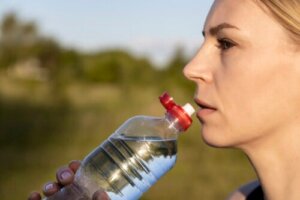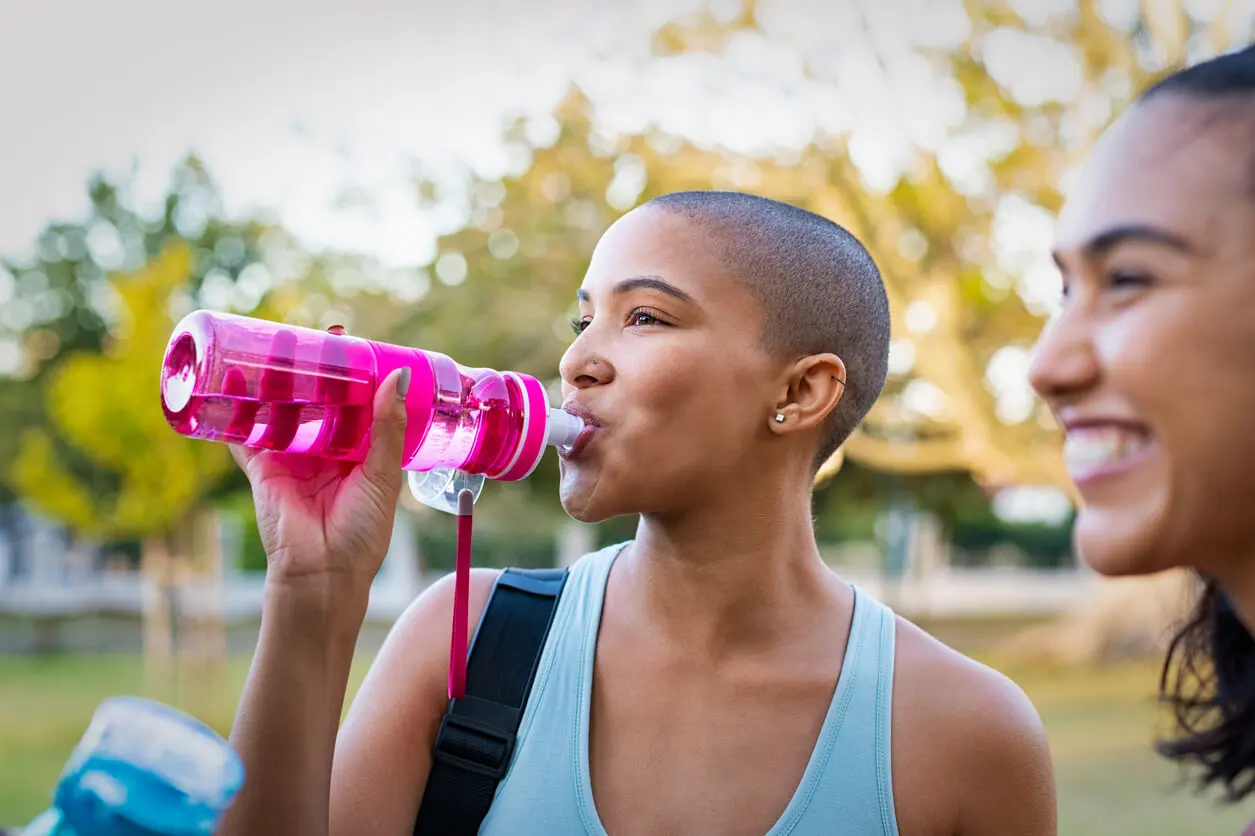How to Clean Reusable Water Bottles and How Often to Clean Them

Bottles are seemingly harmless objects that store the most important element for human nutrition. They’re containers that accompany many everyday tasks. However, cleaning water bottles with considerable frequency and proper technique is as important as sanitizing any utensil.
Water bottles are often stored in the refrigerator, moved to different areas of the home, and sit on the dinner table. In addition, portable versions accompany us to the gym, work, or recreational outings. For this reason, disinfecting bottles is an essential practice to reduce contact with germs.
Why is it important to clean water bottles?
There are more and more types of reusable bottles. There are models made of stainless steel, metal, glass, different cap formats, and also plastic bottles, which should be discarded after the first use. In addition, water bottles with drawings or colors are common, which makes it more difficult to identify if there’s any dirt inside.
However, even if only water passes through, bottles also accumulate dirt, regardless of the material. And this is not only the case for the containers, but also the caps that have nooks and crannies.
According to a study conducted by the EmLab P&K laboratory, athletes’ reusable water bottles accumulate almost 314,000 colony-forming units (CFU) per square centimeter. Through the analysis of different bottles, the work showed that the ones with sliding lids accumulated the most units (more than 900,000).
In other words, they generate optimal conditions for the proliferation of different types of bacteria, especially when exposed to hot and humid environments. Therefore, it’s important to apply daily cleaning methods combined with weekly deep sanitizations.
We think you may also enjoy reading this article: The Health Benefits of Water with a Tablespoon of Apple Cider Vinegar
How to clean reusable water bottles on a daily basis
Refilling bottles with tap water is an option for basic cleaning of the containers. This is because tap water usually contains chlorine, a component that performs surface sanitization.
However, although this may rinse the same on a daily basis, it’s not enough to achieve total, health-safe disinfection. Chlorine helps to eliminate some bacteria, but the quantities of this element in drinking water are minimal and evaporate after a short time, even more so if the container is at room temperature.
When the chlorine has finished evaporating, the bottle once again becomes a breeding ground for millions of bacteria. Bacteria can adhere to the walls or caps. On the other hand, the contact with organic particles brought in by the direct drinking action transforms these containers into objects of mandatory sanitization.

Methods to clean water bottles thoroughly
In order for a reusable bottle to be kept safely for some time, it must be sanitized at least once a week. Different disinfection methods are recommended for this purpose, ranging from electronic solutions to strategies using household items.
Vinegar
One of the most commonly used products for cleaning containers is vinegar. Mixing it with water in equal amounts and letting it stand for 20 minutes is a good method.
However, this doesn’t always achieve complete disinfection, which is the main objective when cleaning water bottles. Therefore, it’s advisable to combine this with other methods.
Bleach
One of the possible home methods is the application of bleach. It’s important to remember that this is a toxic solution, so it must be thoroughly dried after cleaning before drinking water again. Put 1 or 2 drops of bleach in the bottle, fill it with water and shake for a few seconds is enough.
You can let the contents stand for 30 minutes or until you check the clarity. Then, empty the water bottle and let it dry. The use of bleach is recommended if you detect the presence of mold in the bottle.
Soap and water
Soap or detergent for cleaning kitchen utensils is also effective for sanitizing water bottles. Place a few drops in the container, mix with water and shake for a few seconds. When finished, rinse the bottle with warm liquid.
Ammonia for cleaning water bottles
This is a cleaning product with degreasing and disinfectant components. Like bleach, great care must be taken with drying. After placing a minimal amount and mixing with water, soak the bottle and let it dry for a while to make sure there’s no residue.
Dishwasher cleaning
One of the most effective techniques for cleaning water bottles is by using a dishwasher. However, this is an appliance that not everyone owns.
If you have one, place the bottle in it and run a simple cycle. The combination of soaps, the temperature of the water reached by the appliance and the extended washing time achieve a complete disinfection.
On the one hand, you have to make sure that the container is dishwasher friendly. Not all materials are.
In general, with glass and stainless steel, there are no problems. On the other hand, consider washing the lid, too, as it’s likely that it cannot be sanitized in the dishwasher. In such cases, you can apply manual disinfection.

How to disinfect bottle caps
The different models of reusable bottles also include a wide variety of caps. Some are snap-on and others screw-on, but all have recesses that favor the accumulation of bacteria.
To disinfect them, it’s advisable to use a brush to scrub the inside of the bottle during sanitization. Alternatively, they can be soaked in a container filled with water and a few drops of bleach.
Some lids are also dishwasher safe.
The plastic enemy
Many people reuse plastic bottles on several occasions. However, this is an unhealthy practice, due to the small pores that this material has. Although they’re not perceptible, they’re an ideal space for the proliferation of bacteria.
On the other hand, over time, plastic degrades and releases microparticles that can damage health. That’s why the United Nations (UN) advises against the consumption of single-use plastics.
According to a report by this organization, one million plastic bottles are bought every minute. At the same time, 8 million tons of this material end up in the oceans every year.
Like this article? You may also like to read: Learn About the Benefits of Oatmeal Water and How to Make it at Home
Sanitize thermal or travel mugs
Other reusable items that are increasingly consumed are thermal or travel mugs. They may be made from the same materials as bottles; however, they are often transported to other locations. This implies a higher risk of contamination, so they shouldn’t be excluded from your disinfection routines.
Some are dishwasher safe, and, if not, some of the above methods should be applied, including the lids. It’s essential to wash your hands thoroughly to avoid transferring bacteria to the bottle or cup through handling. It’s also important that the container is for personal use and is not shared.
All cited sources were thoroughly reviewed by our team to ensure their quality, reliability, currency, and validity. The bibliography of this article was considered reliable and of academic or scientific accuracy.
- Ávila Larreal, Ayarí Guadalupe, Barboza, Yasmina, Ferrer Villasmil, Kenna Josefina, Rangel Matos, Lisbeth Coromoto, Benítez Payares, Betty Mercedes, Levy, Alegría, Calidad microbiológica del agua potable envasada en bolsas y botellas que se venden en la ciudad de Maracaibo, estado Zulia-Venezuela. Multiciencias [Internet]. 2013;13(1):16-22. Recuperado de: https://www.redalyc.org/articulo.oa?id=90428348002
- Ferrier, Catherine. “Bottled Water: Understanding a Social Phenomenon.” AMBIO: A Journal of the Human Environment 30.2 (2001): 118. Disponible en: https://doi.org/10.1639/0044-7447(2001)030[0118:bwuasp]2.0.co;2
- Maldonado, L., Reducción y reciclaje de residuos sólidos urbanosen centros de educación superior: Estudio de caso. Ingeniería [Internet]. 2006;10(1):59-68. Recuperado de: https://www.redalyc.org/articulo.oa?id=46710106
- Giménez, Andrea F. et al. “Reutilización de Botellas de Plástico En La Localidad de Saladas.” Extensionismo, Innovación y Transferencia Tecnológica 4 (2018): 83. Disponible en:https://doi.org/10.30972/eitt.402876
- Roca Reyes, Juan Carlos , Osores Plenge, Fernando , Domínguez, Nicanor , Rosas Ramos, William , Presencia de bacterias patógenas en las aguas de la desembocadura del Río Surco y la Playa La Chira, Lima, Perú, Junio 2009. Acta Médica Peruana [Internet]. 2009;26(4):243-246. Recuperado de: https://www.redalyc.org/articulo.oa?id=96618984010
This text is provided for informational purposes only and does not replace consultation with a professional. If in doubt, consult your specialist.








